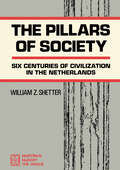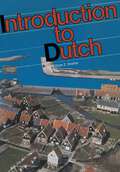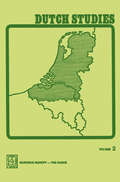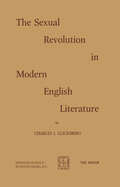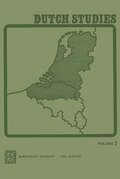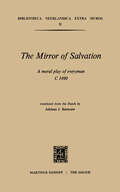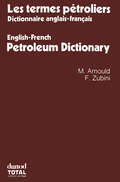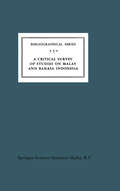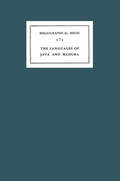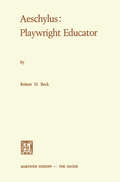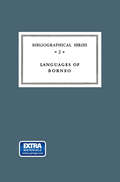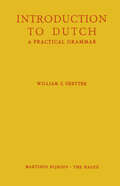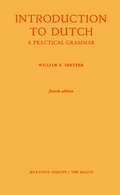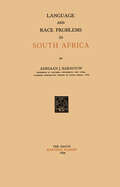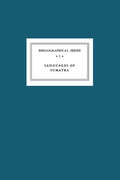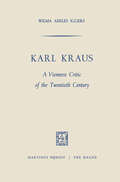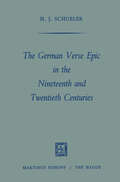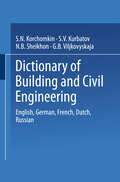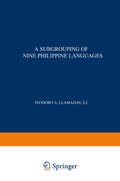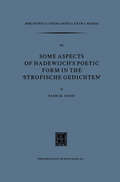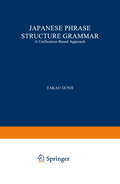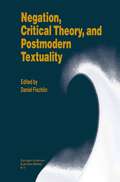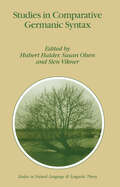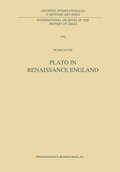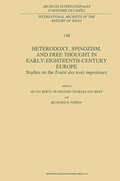- Table View
- List View
Dutch Studies: An annual review of the language, literature and life of the Low Countries Volume 2
by P. Brachin J. Goossens P. K. King J. de RooijThe Sexual Revolution in Modern English Literature
by Ch.I. GlicksbergThe study of its literature is a useful guide to the degree of sexual security existing in a culture. ' When a future historian comes to treat of the social taboos of the nineteenth and twentieth centuries in a fourteen-volume life-work, his theories of the existence of an enormous secret language of bawdry and an immense oral literature of obscene stories and rhymes known, in various degrees of initiation, to every man and woman in the country, yet never consigned to writing or openly admitted as existing, will be treated as a chimerical notion by the enlightened age in which he writes. ' If I were asked to name some characteristics typical of the mid-20th century, I would put first the uncritical worship of money, the spread of nationalism, the tyranny of the orgasm, the homosexual protest and the apotheosis of snobbery. Money, sex, and social climbing motivate society. " The English are, on the whole, an inhibited people. They have a basic prudery and gaucheness in sex matters which sets them apart from almost every other nation in Europe . . . . In England, the realisation that many of the restraints and taboos of Victorian times are unnatural and even psychologically harmful, combined with the decline of organized religion, has led to a considerable laxity in sex matters, particularly since World War II! 1.
Dutch Studies: An annual review of the language, literature and life of the Low Countries
by P. Brachin J. Goossens P. K. King J. de RooijThe language of some eighteen million people living at the junction of the two great cultures of western Europe, Romance and Germanic, is now taught by some 262 teachers at I43 universities outside the Netherlands, ineluding Finland, Hungary, Poland, Russia, Czecho slovakia, Portugal, Japan, Malaysia and South Korea. These teachers obviously need to keep in regular and elose touch with the two countries whose culturallife forms the subject of their courses. Yet the first international congress of Dutch teachers abroad did not take place until the early sixties, since when the Colloquium Neerlandicum has become a triennial event, meeting alternately in the Netherlands and Belgium, in The Hague (I96I and I967), Brussels (I964) Ghent (I970) with the fifth Colloquium planned for Leiden in I973. Financial support from the Dutch and Belgian governments enables the majority of European colleagues, and a number of those from other continents, to attend a conference lasting for four or five days and ineluding discussions of the problems involved in teaching Dutch abroad and papers on various aspects of current Dutch studies of interest to those who are working in a certain degree of isolation abroad. At the first Colloquium a Working Committee of Professors and Lecturers in Dutch studies at Universities abroad was set up.
The Mirror of Salvation: A Moral Play of Everyman c. 1490 (Bibliotheca Neerlandica extra muros #2)
by Adriaan J. BarnouwIn two world wars waged within the life time of one generation Death reaped a prolific harvest. His most formidable scythe in former days was not war but pestilence. But since medical science has forged all kinds of weapons wherewith to strike that dreaded tool out of his knuckles he resorted in our lifetime to a new technique of morticulture which has yielded him un dreamt-of results. Using race hatred as fertilizer he has grown on the soil of the globe a crop of dead whose size baffles the imagination. The executioners whom he employed in Hitler's Germany kept careful record of the loathsome work they did for him in torture camps and gas chambers. They reckoned that six million Jews were delivered to Death by their efforts. In Holland alone only fifteen thousand of her one hundred and fifty thousand Jews survived the massacre. Death was the chief war profiteer. Though his inflated power was reduced by the overthrow of his Nazi henchmen, his innings are still large as he stalks across the world with his satellites Poverty, Hunger, and Disease.
Les termes pétroliers: Dictionnaire anglais-français. English-French Petroleum Dictionary
by Michel Arnould Fabio ZubiniA Critical Survey of Studies on Malay and Bahasa Indonesia: Bibliographical Series 5 (Koninklijk Instituut voor Taal-, Land- en Volkenkunde #5)
by A. TeeuwIn this book I have aimed at completeness in the sense that all publications known to me, which are wholly or partly devoted to Malay and Bahasa Indonesia (B.I.), or are important for the study of these languages, have been included. Popular publications in non-professional periodicals have been included only exceptionally. All the publications mentioned in the text are incorporated in the Bibliography (p. 91-157). The countless articles in four post-war, semi-professional periodicals in :'1alaya and Indonesia, Dewan Bahasa, Pembina Bahasa Indonesia. 11:1 edan Bahasa, Bahasa dan Budaja, are not mentioned separately in the Bibliography, but sections 33 to 36 contain a survey, as complete and systematic as possible, of the contents of these periodicals in so far as they pertain to the Malay language; nor have I discussed in the text or incorporated in the Bibliography several hundreds of titles of practical textbooks or school-books of Malay or B.I. which are of no importance to the scientific study of these language. These titles have been entered in a separate Appendix (p. 158--171). The fact that completeness was aimed at certainly does not mean that it has been achieved. Especially various recent writings from Indonesia and Malaya may have escaped my attention. Experience has also proved that publications on Malay sometimes appear in the most unexpected places. The qualification above: "publications ... devoted to ... , or impor tant for the study of" Malay and B.I. has been taken in a wide sense.
A Critical Survey of Studies on the Languages of Java and Madura: Bibliographical Series 7 (Koninklijk Instituut voor Taal-, Land- en Volkenkunde #3)
by E.M. UhlenbeckAt the completion of this critical bibliography which forms another step in the direction of the realization of the bibliographical project inaugurated in 1955 by Dr. Voorhoeve's survey of the languages of Sumatra, I acknowledge with gratitude the valuable assistance received from various people. I am indebted to my colleagues Prof. Dr. G. W. J. Drewes, Dr. J. Noorduyn, Dr. Th. Pigeaud, Prof. Dr. A. Teeuw and Dr. P. Voorhoeve, who read all or part of the manuscript and who generously put their extensive knowledge of the Java languages at my disposal. Heartfelt thanks are due to Mr. B. J. Hoff and Mr. A. G. Sciarone, both members of my staff, who verified many of the biblio graphical details. I am grateful to the library of the University of Leiden and to the library of the Institute in The Hague because of their readiness in giving me all the facilities I needed for the preparation of this book. Most useful was the cordial assistance received from my colleague Prof. Dr. P. E. de Josselin de Jong, who spent much time correcting the many imperfections of my English text, which greatly promoted the readability of the narrative sections of this survey.
Critical Survey of Studies on the Languages of Borneo (Koninklijk Instituut voor Taal-, Land- en Volkenkunde #2)
by Anton Abraham Cense E.M. UhlenbeckAt the completion of this bibliography, the second of the planned series on language study in Indonesia, the authors acknowledge with gratitude the kind assistance of Father Donatus Dunselman, Dr A. H. Hill and Dr P. Voorhoeve who have read all or part of the manuscript. Also our heartfelt thanks are due to those who have provided us with information indispensable for the compilation of the bibliographical data, or have given us the opportunity to inspect their archives for linguistic literature on Borneo, i.e. the very Rev. A. Antonissen, Jesselton, North Borneo, Father W. Boon, Rector of the Catholic Mission, Mukah, Sarawak, Dr N. C. Scott, the Society for promoting Christian Knowledge, London, the British and Foreign Bible Society, London, the School of Oriental and African Studies, London, the Basle Mission, Basle, Switzerland, the Rhenish Mission, Wuppertal, Germany, the Dutch Bible Society, Amsterdam. The authors greatly appreciate the grant from the Netherland Institute for International Cultural Relations which made this public ation possible.
Introduction to Dutch
by William Z. ShetterThis grammar arose from the need for a concise presentation of the essentials of the Dutch language which could be used both for independent home study and in groups or c1asses under formal instruction. With the former aim in mind, the explanations have been made as self-explanatory as possible, and a complete key to the exercises has been provided in an appendix. In the interest of simplicity and ease of reference and review, each grammatical topic is discussed as fully as practicable in one place, and an effort has been made to inc1ude only one major grammatical feature in any one chapter. But since asolid foundation can more effectively be achieved through study under trained supervision or with a native speaker of the language, the presentation has also been made adaptable to this type of study. The brief fi11-in exercises in each lesson provide a model for any amount of drill, and the dialogues and readings inc1uded at irregular intervals as weIl as the review selections placed after every few chapters can provide the necessary added practice in supervised instruction. Help should in any case be sought with the pronunciation, the principal stumbling-block in the way of either independent or supervised study.
Introduction to Dutch: A Practical Grammar
by William Z. ShetterFirst edition This grammar arose from the need for a concise presentation of the essentials of the Dutch language which could be used both for independent home study and in groups or classes under formal instruction. With the former aim in mind, the explanations have been made as self-explanatory as possible, and a complete key to the exercises has been provided in an appendix. In the interest of simplicity and ease of reference and review, each grammatical topic is discussed as fully as practicable in one place, and an effort has been made to include only one major grammatical feature in any one chapter. But since a solid foundation can more effectively be achieved through study under trained supervision or with a native speaker of the language, the presentation has also been made adapt able to this type of study. The brief fill-in exercises in each lesson provide a model for any amount of drill, and the dialogues and readings included at irregular intervals as well as the review selec tions placed after every few chapters can provide the necessary added practice in supervised instruction. Help should in any case be sought with the pronunciation, the principal stumbling-block in the way of either independent or supervised study.
Critical Survey Of Studies On The Languages of Sumatra (Koninklijk Instituut voor Taal-, Land- en Volkenkunde)
by P. VoorhoeveThe aim of the critical bibliographies, compiled on the initiative of the Board of Directors of the Royal Institute of Linguistics, Geography and Ethnology, is to draw attention to the data on Indonesian lin~ guistics and cultural sciences collected in the past, and to provide guidance in this field. It so happens that these data were often published in journals with a limited circulation, whilst these journals are only available in a few places. Moreover, most of them are only accessible without difficulty to those workers in the fields of Indonesian linguistics and cultural sciences who possess some knowledge of the Dutch language. Apart from providing information, these bibliographies also have an other object, viz. to prevent that meritorious scholarly work would be lost due to the purely fortuitous circumstance - which, however, in actual practice is unfortunately of decisive importance - that this work is not written in a world language and that it cannot be every where easily consulted. The Board therefore hope at the same time to break with the slightly provincialistic nature which for evident reasons used to be characteristic for the studies in language and culture of Indonesia. The Board hope to be able to prevent that new research should have to start unnecessarily again at the very beginning, and also to contribute to a more rapid progress of scientific research in this field by means of a regular publication of these critical reviews of pubIications.
The German Verse Epic in the Nineteenth and Twentieth Centuries
by Heinz Juergen SchuelerThe almost complete disregard of the verse epic as a genre still worthy of meaningful discussion and earnest investigation is all too apparent in German literary criticism. The only attempt to view the genre in its evolution through the centuries is Heinrich Maiworm's valuable but necessarily somewhat perfunctory historical survey of the German epic which appeared in the second volume of Deutsche Philologie im Auf,iss. There is as yet, however, no literary study of the German verse epic in the nineteenth and twentieth centuries, a period which is of particular interest to such a study and indeed crucial to the genre itself, since it was during this period that the novel claimed its final and apparently irrevocable victory over its predecessor, a form which had once been hallowed but was now declared a dead genre. It is not the lack of sufficient material that could explain this neglect, for in terms of sheer quantity and, we believe, not quantity alone, there is enough material for more than one study. The prime purpose of this work, then, is to attempt, if not to fill this conspicuous gap, at least to begin narrowing it somewhat, and in so doing to determine in how far the continuing existence of this vacuum in German literary appreciation is in fact justified.
Dictionary of Building and Civil Engineering: English, German, French, Dutch, Russian
by S. N. Korchomkin S. V. Kurbatov N. B. Sheikhon G. B. ViljkovyskajaIn the last few decades civil engineering has undergone substantial technological change which has, naturally, been reflected in the terminology employed in the industry. Efforts are now being made in many countries to bring about a systematization and unification of technical terminology in general, and that of civil engineering in particular. The publication of a multilingual dictionary of civil engineering terms has been necessitated by the expansion of international cooperation and information exchange in this field, as well as by the lack of suitable updated bilingual dictionaries. This Dictionary contains some 14.000 English terms together with their German, French, Dutch and Russian equivalents, which are used in the main branches of civil engineering and relate to the basic principles of structural design and calculations (the elasticity theory, strength of materials, soil mechanics and other allied technical disciplines); to buildings and installations, structures and their parts, building materials and prefabrications, civil engineering technology and practice, building and road construction machines, construction site equipment, housing equipment and fittings (including modern systems of air conditioning); as well as to hydrotechnical and irrigation constructions. The Dictionary also includes a limited number of basic technical expressions and terms relating to allied disciplines such as architecture and town planning, as well as airfield, railway and underground construction. The Dictionary does not list trade names of building materials, parts and machines or the names of chemical compounds. Nor does it give adverbial, adjective or verbal terms.
A Subgrouping of Nine Philippine Languages
by NA LlamzonBY J. C. ANCEAUX Since the appearance of Brugmann's famous article on the relation ships of the Indo-European languages in 1884, the subject of sub grouping of languages as a methodological problem has been raised only occasionally. To this apparent lack of interest in a major point in comparative linguistics several causes can be assigned. One of them is that a consensus has been reached about the main outlines of the family-tree for the language-family which has received more attention than any other: the Indo-European. Another explanation is that for most of the branches of this family historical materials are available which have proved very valuable for the reconstruction of the inter mediate stages between the proto-Ianguage ande the modem languages. For a few branches only has the problem of subgrouping been a matter for discussion (e.g. Germanic). Special attention, however, could be expected from those who started to apply the comparative methods to other language-families. This attention did come forward, though not immediately, because linguists first had to deal with the problems of proving the existence of the family in question and deciding which languages belonged to it. For the Austronesian languages serious attemps to arrive at a lin guistic classification started relatively late. Certain cases of closer relationships were obvious enough to be recognized very early ( e.g.
Some Aspects of Hadewijch’s Poetic form in the ‘Strofische Gedichten’ (Bibliotheca Neerlandica extra muros #3)
by Tanis M. GuestJapanese Phrase Structure Grammar: A Unification-based Approach (Studies in Natural Language and Linguistic Theory #8)
by T. GunjiThis book is a considerable revision and extension of my thesis for The Ohio State University completed in 1981: A Phrase Structural Analysis of the Japanese Language (Gunji 1981a). The book discusses some of the major grammatical constructions of Japanese in a version of phrase structure grammar called Japanese Phrase Structure Grammar (JPSG), which is loosely based on such frameworks for phrase structure grammar as Generalized Phrase Structure Grammar (GPSG) and Head-driven Phrase Structure Grammar (HPSG). Particular emphasis is placed on the binding and control of pronouns (both implicit - "zero" - and explicit ones, including reflexives) in complementation structures (chapter 4) and adjunction structures (chapter 5). Even though this book started as a revision of my 1981 thesis, the resultant book has few traces of my thinking then. The 1981 thesis was closely related to an early version of GPSG, which was then at a very preliminary stage, and I had only a few preprints of papers by Gerald Gazdar and others to read. GPSG itself has evolved during the past. several years, culminating in a book published last year (Gazdar, Klein, Pullum, and Sag 1985), which differs from the early theory in many ways.
Negation, Critical Theory, and Postmodern Textuality
by Daniel FischlinNegation, Critical Theory, and Postmodern Textuality features 14 new essays by leading specialists in critical theory, comparative literature, philosophy, and English literature. The essays, which present wide-ranging historical considerations of negation in light of recent developments in poststructuralism and postmodernism, range over many of the siginificant texts in which negation figures prominently. The book includes a wide-ranging introductory chapter that examines how attention to negation -- the inescapable nescience that is posited in any and every linguistic expression -- enhances the hermeneutic possibilities present in language. In addition, the four sections of the book bring together major critical interventions on, among others, negative meaning, unrecognizability, elenctic negation, apocalypse, nihilism, negation and gender, and denegation. All the essays involve close attention to key texts by major authors, including William Shakespeare, Henry James, Federico García Lorca, Samuel Beckett, Thomas Bernhard, Walt Whitman, E.M. Forster, Mary Shelley, Margaret Atwood, Roland Barthes, Douglas Barbour, Paul de Man, bp Nichol, Jacques Derrida, and Dogen Kigen. The volume opens up new areas in critical theory, comparative literature, and the philosophy of language, and defines a major new area of inquiry in relation to notions of postmodern textuality. Critical theorists, students of comparative literature, English literature, and the history of ideas, and those interested in the hermeneutic implications of postmodernism will find this volume of substantial interest. Its extensive bibliographical apparatus and index make the collection a valuable reference tool for upper-level undergraduate and graduate students as well as for those seeking a variety of interpretive approaches to the problem of negation in literature.
Studies in Comparative Germanic Syntax (Studies in Natural Language and Linguistic Theory #31)
by H. Haider S. Olsen S. Viknero. COMPARATIVE GERMANIC SYNTAX This volume contains 13 papers that were prepared for the Seventh Workshop on Comparative Germanie Syntax at the University of Stuttgart in November 1991. In defining the theme both of the workshop and of this volume, we have taken "comparative" in "comparative Germanic syntax" to mean that at least two languages should be analyzed and "Germanic" to mean that at least one of these languages should be Germanic. There was no require ment as such that the research presented should be situated within the framework known as Principles and Parameters Theory (previously known as Government and Binding Theory), though it probably is no accident that this nevertheless turned out to be the case. Within this theory, it is seen as highly desirable to be able to account for several differences on the surface by deriving them from fewer under lying differences. The reason is that, in order to explain the ease with which children acquire language, it is assumed that not all knowledge of any given language is the result of learning, but that instead children already possess part of this knowledge at birth (the innate part of linguistic knowledge will obviously be the same for all human beings, and thus this theory also provides an explanation of language universals). The fewer "real" (i.e.
Plato in Renaissance England (International Archives of the History of Ideas Archives internationales d'histoire des idées #141)
by S. JayneThis book offers a radical reappraisal of the reputation of Plato in England between 1423 and 1603. Using many materials not hitherto available, including evidence of book publishing and book ownership, together with a comprehensive survey of allusions to Plato, the author shows that the English were far less interested in Plato than most historians have thought. Although the English, like the French, knew the `court' Plato as well as the `school' Plato, the English published only two works by Plato during this period, while the French published well over 100 editions, including several of the complete Works. In England allusions to Plato occur more often in prose writers such as Whetstone, Green, and Lodge, than in poets like Spenser and Chapman. Sidney did take his `Stella' from Plato, but most English allusions to Plato were taken not directly from Plato or from Ficino, but from other authors, especially Mornay, Nani-Mirabelli, Ricchieri, Steuco, and Tixier.
Heterodoxy, Spinozism, and Free Thought in Early-Eighteenth-Century Europe: Studies on the Traité des Trois Imposteurs (International Archives of the History of Ideas Archives internationales d'histoire des idées #148)
by Silvia Berti Françoise Charles-Daubert R. H. Popkin'the oldest biography of Spinoza', La Vie de Mr. Spinosa, which in the manuscript copies is often followed by L'Esprit de M. Spinosa. Margaret Jacob, in her Radical Enlightenment, contended that the Traite was written by a radical group of Freemasons in The Hague in the early eighteenth century. Silvia Berti has offered evidence it was written by Jan Vroesen. Various discussions in the early eighteenth century consider many possi ble authors from the Renaissance onwards to whom the work might be attributed. The Trois imposteurs has attracted quite a bit of recent attention as one of the most significant irreligious clandestine writings available in the Enlightenment, which is most important for understanding the develop ment of religious scepticism, radical deism, and even atheism in the seventeenth and eighteenth centuries. Scholars for the last couple of decades have been trying to assess when the work was actually written or compiled and by whom. In view of the widespread distribution of manu scripts of the work all over Europe, they have also been seeking to find out who was influenced by the work, and what it represented for its time. Hitherto unknown manuscripts are being turned up in public and private libraries all over Europe and the United States.
